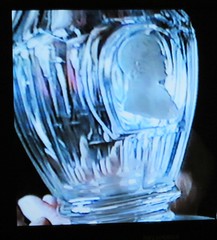
PREV ARTICLE
NEXT ARTICLE
FULL ISSUE
PREV FULL ISSUE
CAMEO INCRUSTRATIONS AND PLATINUM USE IN GLASSMAKING
Dick Johnson's article was most interesting to me. Whenever my mother discussed the pitcher, she would say she wasn't sure how the bust was put on, but she thought she had heard the process involved platinum. She would have heard this from her father, a trained chemist, or her grandfather Jacob B. Eckfeldt, the assayer. No chemist myself (nor was my mother - we didn't inherit the scientific genes!), I am curious if platinum could have been the material used to treat the clay in this case, just to corroborate my mother's recollection. So I put the question to Dick Johnson, who writes: Mother was partly right. Platinum is widely used in glass making. But it was not necessary for making cameo incrustations. I am not an expert in glassmaking (my expertise is the relief that was molded in the glass). It appears from reading the literature that the molds for glass objects are often made of platinum for several characteristics of the metal. It can withstand the heat necessary for containing the molten glass, it can be formed to any shape -- and best of all -- the platinum metal can be reused. It appears platinum can be used for what I call "long press runs." (I don't know the equivalent term for glassmaking.) Let's just say a large number molded glass objects can be made from the same mold, used over and over. I don't believe this was the case for the Eckfeldt pitcher. Particularly since there are so few of these, a great quantity apparently were not made.
To read more click on this article:
Don't discredit what mother said. Just recognize it was not necessary for her pitcher.
Thanks to everyone for the continued elaboration on the topic. See what you can learn from The E-Sylum? Please to continue to pass the word and keep a lookout for this heirloom pitcher with a great numismatic connection.
-Editor
On a related note, Joel Orosz adds: Dick Johnson's responds was highly informative but contained an error. Adam Eckfeldt was not the first Chief Coiner. Henry Voigt was the first Chief Coiner, 1792-1814. Adam Eckfeldt was the second, 1814-1839.
To read the earlier E-Sylum articles, see:
CAMEO INCRUSTATIONS AND THE ADAM ECKFELDT PITCHER
(www.coinbooks.org/esylum_v15n08a06.html)
THE BOOK BAZARREWayne Homren, Editor The Numismatic Bibliomania Society is a non-profit organization promoting numismatic literature. See our web site at coinbooks.org. To submit items for publication in The E-Sylum, write to the Editor at this address: whomren@gmail.com To subscribe go to: https://my.binhost.com/lists/listinfo/esylum All Rights Reserved. NBS Home Page Contact the NBS webmaster 
|
